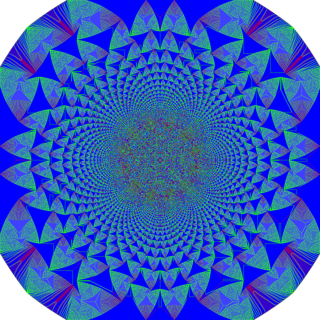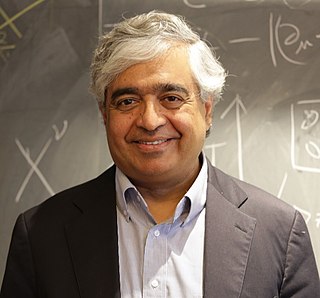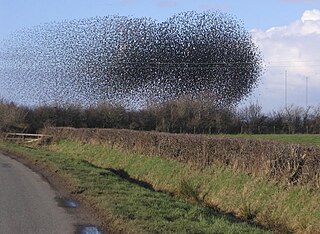Related Research Articles

Self-organized criticality (SOC) is a property of dynamical systems that have a critical point as an attractor. Their macroscopic behavior thus displays the spatial or temporal scale-invariance characteristic of the critical point of a phase transition, but without the need to tune control parameters to a precise value, because the system, effectively, tunes itself as it evolves towards criticality.
In applied mathematics, highly optimized tolerance (HOT) is a method of generating power law behavior in systems by including a global optimization principle. It was developed by Jean M. Carlson and John Doyle in the early 2000s. For some systems that display a characteristic scale, a global optimization term could potentially be added that would then yield power law behavior. It has been used to generate and describe internet-like graphs, forest fire models and may also apply to biological systems.

The Bak–Sneppen model is a simple model of co-evolution between interacting species. It was developed to show how self-organized criticality may explain key features of the fossil record, such as the distribution of sizes of extinction events and the phenomenon of punctuated equilibrium. It is named after Per Bak and Kim Sneppen.

Tang Chao is a Chair Professor of Physics and Systems Biology at Peking University.
In physics, the Tsallis entropy is a generalization of the standard Boltzmann–Gibbs entropy.
Extremal optimization (EO) is an optimization heuristic inspired by the Bak–Sneppen model of self-organized criticality from the field of statistical physics. This heuristic was designed initially to address combinatorial optimization problems such as the travelling salesman problem and spin glasses, although the technique has been demonstrated to function in optimization domains.

A Boolean network consists of a discrete set of boolean variables each of which has a Boolean function assigned to it which takes inputs from a subset of those variables and output that determines the state of the variable it is assigned to. This set of functions in effect determines a topology (connectivity) on the set of variables, which then become nodes in a network. Usually, the dynamics of the system is taken as a discrete time series where the state of the entire network at time t+1 is determined by evaluating each variable's function on the state of the network at time t. This may be done synchronously or asynchronously.

The percolation threshold is a mathematical concept in percolation theory that describes the formation of long-range connectivity in random systems. Below the threshold a giant connected component does not exist; while above it, there exists a giant component of the order of system size. In engineering and coffee making, percolation represents the flow of fluids through porous media, but in the mathematics and physics worlds it generally refers to simplified lattice models of random systems or networks (graphs), and the nature of the connectivity in them. The percolation threshold is the critical value of the occupation probability p, or more generally a critical surface for a group of parameters p1, p2, ..., such that infinite connectivity (percolation) first occurs.

Subir Sachdev is Herchel Smith Professor of Physics at Harvard University specializing in condensed matter. He was elected to the U.S. National Academy of Sciences in 2014, and received the Lars Onsager Prize from the American Physical Society and the Dirac Medal from the ICTP in 2018. He was a co-editor of the Annual Review of Condensed Matter Physics from 2017–2019.
Human dynamics refer to a branch of complex systems research in statistical physics such as the movement of crowds and queues and other systems of complex human interactions including statistical modelling of human networks, including interactions over communications networks.
Multi-particle collision dynamics (MPC), also known as stochastic rotation dynamics (SRD), is a particle-based mesoscale simulation technique for complex fluids which fully incorporates thermal fluctuations and hydrodynamic interactions. Coupling of embedded particles to the coarse-grained solvent is achieved through molecular dynamics.

Active matter is matter composed of large numbers of active "agents", each of which consumes energy in order to move or to exert mechanical forces. Such systems are intrinsically out of thermal equilibrium. Unlike thermal systems relaxing towards equilibrium and systems with boundary conditions imposing steady currents, active matter systems break time reversal symmetry because energy is being continually dissipated by the individual constituents. Most examples of active matter are biological in origin and span all the scales of the living, from bacteria and self-organising bio-polymers such as microtubules and actin, to schools of fish and flocks of birds. However, a great deal of current experimental work is devoted to synthetic systems such as artificial self-propelled particles. Active matter is a relatively new material classification in soft matter: the most extensively studied model, the Vicsek model, dates from 1995.

Piers Coleman is a British-born theoretical physicist, working in the field of theoretical condensed matter physics. Coleman is professor of physics at Rutgers University in New Jersey and at Royal Holloway, University of London.
Maya Paczuski is the head and founder of the Complexity Science Group at the University of Calgary. She is a well-cited physicist whose work spans self-organized criticality, avalanche dynamics, earthquake, and complex networks. She was born in Israel in 1963, but grew up in the United States. Maya Paczuski received a B.S. and M.S. in Electrical Engineering and Computer Science from M.I.T. in 1986 and then went on to study with Mehran Kardar, earning her Ph.D in Condensed matter physics from the same institute.
The Kibble–Zurek mechanism (KZM) describes the non-equilibrium dynamics and the formation of topological defects in a system which is driven through a continuous phase transition at finite rate. It is named after Tom W. B. Kibble, who pioneered the study of domain structure formation through cosmological phase transitions in the early universe, and Wojciech H. Zurek, who related the number of defects it creates to the critical exponents of the transition and to its rate—to how quickly the critical point is traversed.
In neuroscience, the critical brain hypothesis states that certain biological neuronal networks work near phase transitions. Experimental recordings from large groups of neurons have shown bursts of activity, so-called neuronal avalanches, with sizes that follow a power law distribution. These results, and subsequent replication on a number of settings, led to the hypothesis that the collective dynamics of large neuronal networks in the brain operates close to the critical point of a phase transition. According to this hypothesis, the activity of the brain would be continuously transitioning between two phases, one in which activity will rapidly reduce and die, and another where activity will build up and amplify over time. In criticality, the brain capacity for information processing is enhanced, so subcritical, critical and slightly supercritical branching process of thoughts could describe how human and animal minds function.

Antonio Helio de Castro Neto is a Brazilian-born physicist. He is the founder and director of the Centre for Advanced 2D Materials at the National University of Singapore. He is a condensed matter theorist known for his work in the theory of metals, magnets, superconductors, graphene and two-dimensional materials. He is a distinguished professor in the Departments of Materials Science Engineering, and Physics and a professor at the Department of Electrical and Computer Engineering. He was elected as a fellow of the American Physical Society in 2003. In 2011 he was elected as a fellow of the American Association for the Advancement of Science.

A hopfion is a topological soliton. It is a stable three-dimensional localised configuration of a three-component field with a knotted topological structure. They are the three-dimensional counterparts of skyrmions, which exhibit similar topological properties in 2D.
Dov I. Levine is an American-Israeli physicist, known for his research on quasicrystals, soft condensed matter physics, and statistical mechanics out of equilibrium.
Quantum turbulence involves the chaotic dynamics of many interacting quantum vortices. In highly excited bulk superfluid, many vortex lines interact with each other forming quantum turbulent states. By introducing tight confinement along one direction the Kelvin wave excitations can be strongly suppressed, favouring vortex alignment with the axis of tight confinement. Vortex dynamics enters a regime of effective 2D motion, equivalent to point vortices moving on a plane. In general, 2D quantum turbulence (2DQT) can exhibit complex phenomenology involving coupled vortices and sound in compressible superfluids. The quantum vortex dynamics can exhibit signatures of turbulence including a Kolmogorov −5/3 power law, a quantum manifestation of the inertial transport of energy to large scales observed in classical fluids, known as an inverse energy cascade.
References
- ↑ Chialvo D.R.; Bak P. (1999). "Learning from mistakes". Neuroscience. 90 (4): 1137–48. arXiv: adap-org/9707006 . doi:10.1016/S0306-4522(98)00472-2. PMID 10338284. S2CID 1304836.
- ↑ Bak P, Chialvo DR (2001). "Adaptive learning by extremal dynamics and negative feedback". Physical Review E. 63 (3): 031912. arXiv: cond-mat/0009211 . Bibcode:2001PhRvE..63c1912B. doi:10.1103/PhysRevE.63.031912. PMID 11308683. S2CID 13900758.
- ↑ "Toward a Theory of Self-Organized Criticality in the Brain | Quanta Magazine". Quanta Magazine. Retrieved 2017-06-10.
- ↑ Eguíluz V.M.; Chialvo D.R.; Cecchi G.; Baliki M.; Apkarian A.V. (2005). "Scale-free brain functional networks". Physical Review Letters. 94 (1): 018102. arXiv: cond-mat/0309092 . Bibcode:2005PhRvL..94a8102E. doi:10.1103/PhysRevLett.94.018102. PMID 15698136. S2CID 7115880.
- ↑ Chialvo, D. R. (2004). "Critical brain networks". Physica A. 340 (4): 756–765. arXiv: cond-mat/0402538 . Bibcode:2004PhyA..340..756R. doi:10.1016/j.physa.2004.05.064. S2CID 15922916.
- ↑ D. Fraiman; P. Balenzuela; J. Foss; D. R. Chialvo (2004). "Ising-like dynamics in large scale brain functional networks". Physical Review E. 79 (6): 061922. arXiv: 0811.3721 . Bibcode:2009PhRvE..79f1922F. doi:10.1103/PhysRevE.79.061922. PMC 2746490 . PMID 19658539.
- ↑ D. R. Chialvo (2010). "Emergent complex neural dynamics". Nature Physics. 6 (10): 744–750. arXiv: 1010.2530 . Bibcode:2010NatPh...6..744C. doi:10.1038/nphys1803. S2CID 17584864.
- ↑ "Chialvo awarded Fulbright", Newscenter, September 25, 2005.
- ↑ "", Newscenter, January 22, 2008.
- ↑ "Fellows". American Physical Society . Retrieved 11 December 2009.
- ↑ "ACAL, Académicos 2021-2022 | ACAL". www.acal-scientia.org. Retrieved 2022-06-02.